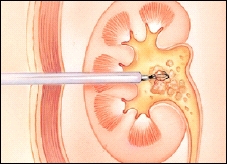Scientific Editor: Editorial Board ISUD website
What is Percutaneous Nephrolithotripsy (PCNL)?
Percutaneous Nephrolithotripsy is a minimally invasive surgical procedure to fragment and remove stones from the kidney through a small incision at the patient’s back. It is performed with the use of a telescopic camera that is called nephroscope
When is PCNL performed?
Percutaneous Nephrolithotripsy is usually performed to remove renal stones that cause symptoms (pain, obstruction, urinary tract infections etc), are larger than 2cm or cannot be fragmented with the method of Extracorporeal Shock Wave Lithotripsy (ESWL). By undergoing PCNL, the patient avoids open surgery, stays less in hospital and recovers faster.
What sort of preparation is required?
Upon hospital admission, preoperative preparation includes blood tests, chest X-ray and ECG (electrocardiogram). In case you are on anticoagulant therapy, it may be required to interrupt your anticoagulant therapy a few days before the operation. You should always consult your Cardiologist, for there may be need to replace anticoagulants with low molecular heparin injections in the abdominal region.
How is PCNL performed?
PCNL is performed under general anesthesia, with the patient sleeping throughout the procedure. It usually takes place at one stage. Initially, a small catheter is inserted to the ureter through a cystoscope from the bladder. Then the patient is turned to the prone position (on stomach) and the surgeon opens up a small hole at patient's back with the use of a radiological device to create a passage from the skin down to the kidney. A special telescopic instrument, called nephroscope, is inserted to the kidney, fragments and removes the stones. At the end of the procedure, a catheter is usually placed to the bladder and a drainage tube to the kidney. Should there be too many or too large kidney stones, the surgeon may have to open up more than one skin incision. The bladder and kidney catheter are usually removed after 24-48 hours, and hospital stay usually lasts 2-5 days.
What about after the procedure?
Upon discharge from hospital, you will be given specific instructions about:
- when it is safe to restart your anticoagulant therapy
- when you can resume to intense physical activity and work
- what sort of antibiotic regimen you should take postoperatively
What is the effect of PCNL on patient’s quality of life?
Most patients have absolutely no problem after the intervention. You should drink plenty of fluids, so that urine clears up. It usually takes about 10 days to resume to your normal life activities. Of course, you should always follow your doctor’s instructions carefully. In some cases, it may not be possible to remove all kidney stones and, thus, revision surgery will be needed.



